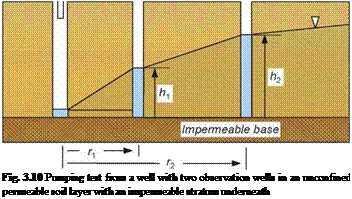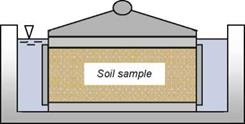Oedometer Test
The coefficient of permeability can be determined as a function of vertical strain in an oedometer test (see Fig. 3.9). The method is normally used for fine-grained (frictionless) soils to estimate their consolidation characteristics. The oedometer test is usually performed either as a constant stress or constant-rate-of-strain test. In a one-dimensional constant stress test a cylindrical specimen of soil enclosed in a stiff metal ring is subjected to a series of increasing static loads, while changes in thickness are recorded against time. The coefficient of permeability is given as:
|
(3.11) |
|
K — cv ■ m v ■ Vw cv ■ m v ■ Pwg |
|
where cv is the coefficient of consolidation, mv is the coefficient of volume compressibility, yw is the unit weight of water and g is the acceleration due to gravity. |
|
^ Load
|
|
Fig. 3.9 Constant stress oedometer test |
|
In the field, the average coefficient of permeability of a soil deposit can be determined by performing a pumping test where water is pumped from a well at a constant rate over a certain period of time. With time the drawdown of the water |
table or the piezometric head will reach a steady state. The rate of discharge, q, from pumping is equal to the rate of flow of groundwater into the well, or
where h is the piezometric head at the radial distance, r, from the centre of the well.
By separating the two variables r and h and integrating between the two observation wells at distances rj and r2 respectively from the test well, the permeability coefficient can easily be determined (see Fig. 3.10) as:
![]() q ln(r2/rQ n (h2 — h 2)
q ln(r2/rQ n (h2 — h 2)
 |
q
Injection tests, which are the reciprocal of pumping tests, are normally conducted by pumping water or air into a test section of a borehole and measuring the flow rate. By performing tests at intervals along the entire length of a borehole, a permeability profile can be obtained. Air (or another gas) is used as the “fluid” when testing areas of high permeability, as water cannot be provided at a high enough flow rate for such conditions.







Leave a reply